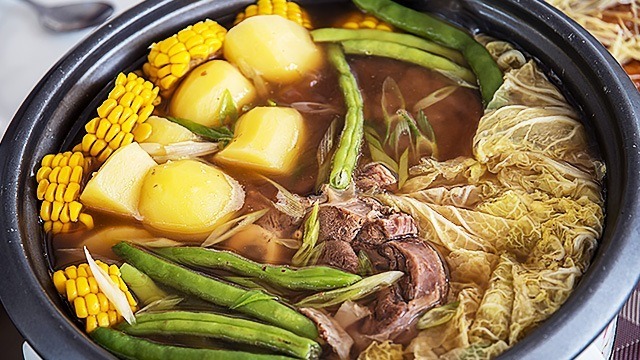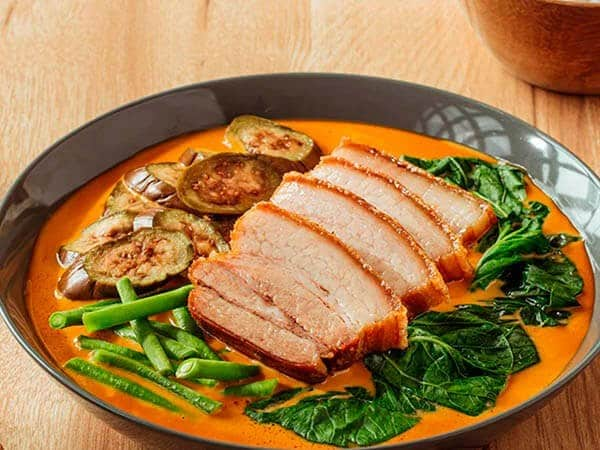Discover the Rich Taste of Filipino Cuisine With These Must-Try Recipes
Filipino food uses an amazing tapestry of tastes that reflect the nation's abundant social heritage. Each dish informs a story, from the savory depth of Adobo to the revitalizing flavor of Sinigang, welcoming cooking lovers to explore a diverse array of tastes.
Adobo: The Iconic Recipe
Adobo has actually become the quintessential recipe of Filipino cuisine, fascinating palates both locally and abroad. This precious recipe is characterized by its special mix of savory, sour, and slightly pleasant tastes, attained through a precise marination procedure. Typically, adobo is prepared making use of hen or pork, although variants exist that include fish and shellfish and vegetables.
The fundamental active ingredients of adobo include soy sauce, vinegar, garlic, bay leaves, and black pepper, which with each other create a rich and fragrant sauce. The food preparation approach generally entails simmering the meat in the sauce, permitting it to take in the complex tastes while coming to be tender. This process not just enhances the preference but additionally works as an all-natural preservative, making adobo an ideal dish for storage space.
Adobo is often served with fit to be tied rice, which enhances its durable taste profile. Each region in the Philippines flaunts its own variation, mirroring regional components and culinary practices. This adaptability talks to the dish's social relevance and enduring appeal. Whether delighted in in the house or in restaurants, adobo remains a staple that symbolizes the significance of Filipino hospitality, making it a must-try for any person exploring this lively food.

Sinigang: A Tangy Delight
An additional cornerstone of Filipino cuisine is sinigang, a recipe commemorated for its distinct tasty taste. This full-flavored soup is typically made with a selection of meats, including pork, beef, shrimp, or fish, and is characterized by its sour brew, which usually derives from tamarind, eco-friendly mango, or calamansi. The equilibrium of acidity and umami produces a refreshing comparison that is both soothing and stimulating.
Sinigang is typically enriched with a range of fresh vegetables such as radish, eggplant, water spinach, and string beans, adding not only to the dish's taste account but also to its dietary worth - Filipino food recipes. Each family may have its very own version, with local variations that mirror regional active ingredients and cultural influences
The preparation of sinigang includes simmering the picked meat until tender, complied with by the enhancement of the souring representative and vegetables. This technique enables the flavors to combine perfectly, leading to a hearty and rewarding dish. Commonly offered with steamed rice, sinigang embodies the essence of Filipino hospitality and is a cherished staple, more helpful hints frequently enjoyed throughout family events and unique occasions.
Lechon: The Cheery Roast
Lechon, commonly considered as the focal point of cheery Filipino parties, is a delicious baked pig known for its crunchy skin and tender, flavorful meat. This famous dish is deeply rooted in Filipino culture, usually beautifying tables throughout birthdays, wedding events, and considerable holidays. The prep work of lechon is an art form, calling for thorough focus to information, from marinading the pig with a mix of seasonings to making certain an even roast over an open fire or in a specialized oven.
Typically, the pig is skilled with a mixture of salt, pepper, and regional herbs, imparting a rich taste that complements its natural juiciness. The cooking process can take several hours, throughout which the skin transforms right into a perfectly crispy layer, creating a fascinating contrast to the delicious meat underneath.
Lechon is typically served with a side of liver sauce or vinegar dip, enhancing its mouthwatering account. It is not just a meal however a public experience, as friends and families collect around to appreciate this luxurious dish. The aroma of lechon wafting via the air is an invite to delight, making it a cherished symbol of event in Filipino society.
Kare-Kare: Oxtail Stew
Kare-Kare, a rich and passionate oxtail stew, holds a special location in Filipino cooking tradition, commemorated for its distinct taste profile and vibrant presentation (Filipino food recipes). This recipe here is identified by its delicious peanut sauce, which is produced by grinding roasted peanuts or making use of peanut butter, offering it a luscious and nutty essence. Typically, kare-kare attributes tender oxtail, although variants may consist of tripe or beef shank, each adding to the stew's depth of taste
The prep work of kare-kare typically entails slow-cooking the meat till it ends up being remarkably tender. The addition of a selection of vegetables, such as eggplant, string beans, and banana hearts, not just boosts the stew's nutritional value however likewise its aesthetic allure. Served with a side of bagoong, or fermented shrimp paste, kare-kare wonderfully balances its rich, mouthwatering notes with a salted kick.
Frequently enjoyed during special events and family click here for info members events, kare-kare embodies the significance of communal eating in Filipino society. Its delightful intricacy and soothing warmth make it a recipe that is not only satisfying to the taste however additionally evokes a feeling of fond memories for numerous Filipinos around the world.

Halo-Halo: A Sweet Reward
Halo-halo is usually related to as the essential Filipino treat, celebrated for its lively mix of textures and flavors - Filipino food recipes. This wonderful mixture is an excellent depiction of the Philippines' rich cooking heritage, integrating various components that integrate to create a revitalizing and indulgent reward, especially throughout heat
At its core, halo-halo functions crushed ice covered with a range of ingredients, consisting of sweetened beans, jellies, fruits like bananas and jackfruit, and creamy leche flan. A charitable scoop of ube (purple yam) gelato crowns the mixture, adding a rich, velvety flavor that raises the dessert. The layering of active ingredients not only produces a feast for the eyes but additionally gives an intricate interplay of sweetness and structure in every dose.
Traditionally offered in a glass, halo-halo motivates restaurants to blend the components prior to savoring. This public facet boosts the dessert's allure, as everyone's version can be distinctly customized. Whether appreciated as a road food extravagance or a special event treat, halo-halo stays a beloved sign of Filipino culture, welcoming every person to explore its wonderful and varied flavors.
Final Thought
